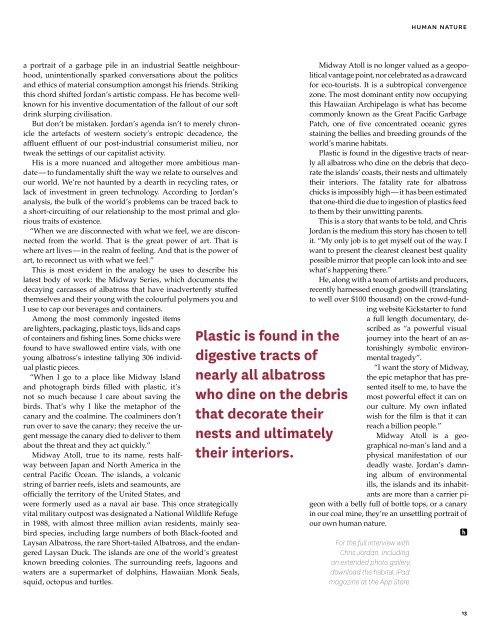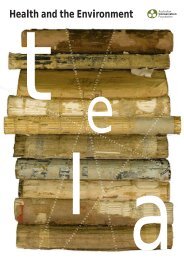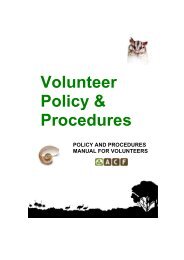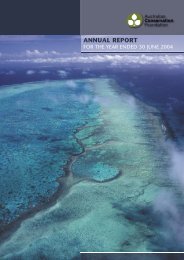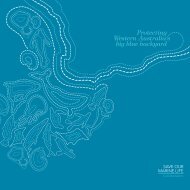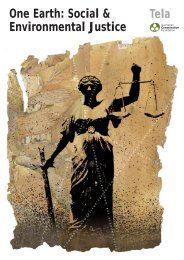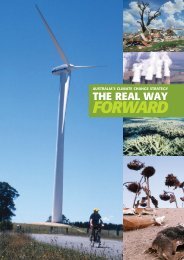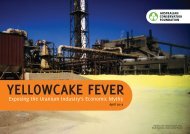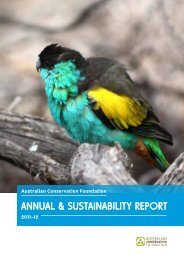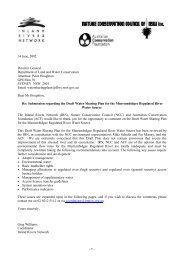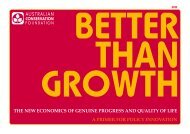pdf of habitat - Australian Conservation Foundation
pdf of habitat - Australian Conservation Foundation
pdf of habitat - Australian Conservation Foundation
- No tags were found...
You also want an ePaper? Increase the reach of your titles
YUMPU automatically turns print PDFs into web optimized ePapers that Google loves.
Human naturea portrait <strong>of</strong> a garbage pile in an industrial Seattle neighbourhood,unintentionally sparked conversations about the politicsand ethics <strong>of</strong> material consumption amongst his friends. Strikingthis chord shifted Jordan’s artistic compass. He has become wellknownfor his inventive documentation <strong>of</strong> the fallout <strong>of</strong> our s<strong>of</strong>tdrink slurping civilisation.But don’t be mistaken. Jordan’s agenda isn’t to merely chroniclethe artefacts <strong>of</strong> western society’s entropic decadence, theaffluent effluent <strong>of</strong> our post-industrial consumerist milieu, nortweak the settings <strong>of</strong> our capitalist activity.His is a more nuanced and altogether more ambitious mandate— to fundamentally shift the way we relate to ourselves andour world. We’re not haunted by a dearth in recycling rates, orlack <strong>of</strong> investment in green technology. According to Jordan’sanalysis, the bulk <strong>of</strong> the world’s problems can be traced back toa short-circuiting <strong>of</strong> our relationship to the most primal and glorioustraits <strong>of</strong> existence.“When we are disconnected with what we feel, we are disconnectedfrom the world. That is the great power <strong>of</strong> art. That iswhere art lives — in the realm <strong>of</strong> feeling. And that is the power <strong>of</strong>art, to reconnect us with what we feel.”This is most evident in the analogy he uses to describe hislatest body <strong>of</strong> work: the Midway Series, which documents thedecaying carcasses <strong>of</strong> albatross that have inadvertently stuffedthemselves and their young with the colourful polymers you andI use to cap our beverages and containers.Among the most commonly ingested itemsare lighters, packaging, plastic toys, lids and caps<strong>of</strong> containers and fishing lines. Some chicks werefound to have swallowed entire vials, with oneyoung albatross’s intestine tallying 306 individualplastic pieces.“When I go to a place like Midway Islandand photograph birds filled with plastic, it’snot so much because I care about saving thebirds. That’s why I like the metaphor <strong>of</strong> thecanary and the coalmine. The coalminers don’trun over to save the canary; they receive the urgentmessage the canary died to deliver to themabout the threat and they act quickly.”Midway Atoll, true to its name, rests halfwaybetween Japan and North America in thecentral Pacific Ocean. The islands, a volcanicstring <strong>of</strong> barrier reefs, islets and seamounts, are<strong>of</strong>ficially the territory <strong>of</strong> the United States, andwere formerly used as a naval air base. This once strategicallyvital military outpost was designated a National Wildlife Refugein 1988, with almost three million avian residents, mainly seabirdspecies, including large numbers <strong>of</strong> both Black-footed andLaysan Albatross, the rare Short-tailed Albatross, and the endangeredLaysan Duck. The islands are one <strong>of</strong> the world’s greatestknown breeding colonies. The surrounding reefs, lagoons andwaters are a supermarket <strong>of</strong> dolphins, Hawaiian Monk Seals,squid, octopus and turtles.Plastic is found in thedigestive tracts <strong>of</strong>nearly all albatrosswho dine on the debristhat decorate theirnests and ultimatelytheir interiors.Midway Atoll is no longer valued as a geopoliticalvantage point, nor celebrated as a drawcardfor eco-tourists. It is a subtropical convergencezone. The most dominant entity now occupyingthis Hawaiian Archipelago is what has becomecommonly known as the Great Pacific GarbagePatch, one <strong>of</strong> five concentrated oceanic gyresstaining the bellies and breeding grounds <strong>of</strong> theworld’s marine <strong>habitat</strong>s.Plastic is found in the digestive tracts <strong>of</strong> nearlyall albatross who dine on the debris that decoratethe islands’ coasts, their nests and ultimatelytheir interiors. The fatality rate for albatrosschicks is impossibly high — it has been estimatedthat one-third die due to ingestion <strong>of</strong> plastics feedto them by their unwitting parents.This is a story that wants to be told, and ChrisJordan is the medium this story has chosen to tellit. “My only job is to get myself out <strong>of</strong> the way. Iwant to present the clearest cleanest best qualitypossible mirror that people can look into and seewhat’s happening there.”He, along with a team <strong>of</strong> artists and producers,recently harnessed enough goodwill (translatingto well over $100 thousand) on the crowd-fundingwebsite Kickstarter to funda full length documentary, describedas “a powerful visualjourney into the heart <strong>of</strong> an astonishinglysymbolic environmentaltragedy”.“I want the story <strong>of</strong> Midway,the epic metaphor that has presenteditself to me, to have themost powerful effect it can onour culture. My own inflatedwish for the film is that it canreach a billion people.”Midway Atoll is a geographicalno-man’s land and aphysical manifestation <strong>of</strong> ourdeadly waste. Jordan’s damningalbum <strong>of</strong> environmentalills, the islands and its inhabitantsare more than a carrier pigeonwith a belly full <strong>of</strong> bottle tops, or a canaryin our coal mine, they’re an unsettling portrait <strong>of</strong>our own human nature.For the full interview withChris Jordan, includingan extended photo gallery,download the <strong>habitat</strong> iPadmagazine at the App Store.<strong>habitat</strong>13


